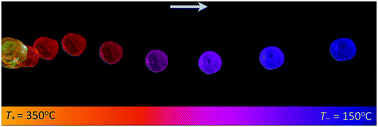Thermophobic Leidenfrost†
Abstract
We report that a volatile liquid deposited on a hot substrate with a gradient of temperature does not only levitate (Leidenfrost effect), but also spontaneously accelerates to the cold. This thermophobic effect is also observed with sublimating solids, and we attribute it to the ability of temperature differences to tilt (slightly) the base of the “object”, which induces a horizontal component to the levitating force. This scenario is tested by varying the drop size (with which the acceleration increases) and the substrate temperature (with which the acceleration decreases), showing that the effect can be used to control, guide and possibly trap the elusive Leidenfrost drops.

- This article is part of the themed collection: Soft Matter Editor-in-Chief's Choice


 Please wait while we load your content...
Please wait while we load your content...